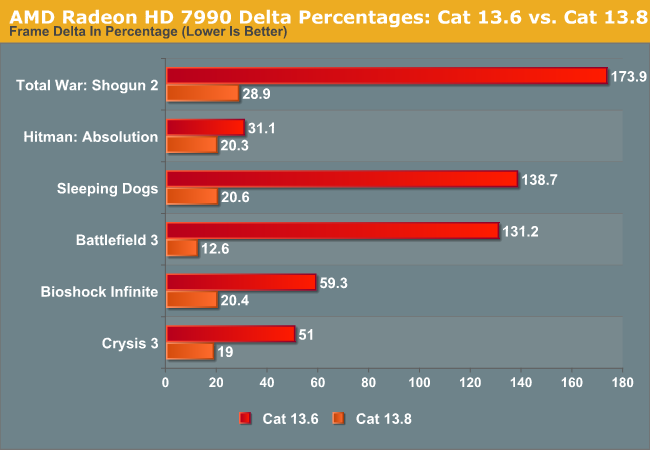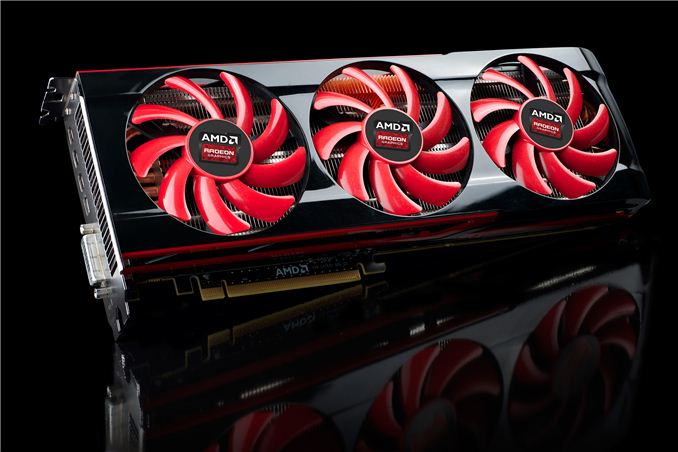AMD Frame Pacing Explored: Catalyst 13.8 Brings Consistency to Crossfire
by Ryan Smith on August 1, 2013 2:00 PM ESTFinal Words
Bringing things to a close, today’s driver release isn’t about any grand revelations for AMD, but rather about AMD following through on their plans and commitments to improve frame time consistency on their products. We’ve seen AMD get their house in order with respect to single-GPU cards earlier this year, and now the same is starting to happen for multi-GPU setups.
To be clear here AMD’s initial situation should never have happened. AMD should have been doing the appropriate competitive analysis from the start, never letting themselves fall behind like this. But we aren’t in the business of berating companies that make an honest effort to improve their products like AMD is doing, so while AMD could have done better in the past they are finally making the right moves in the present, and it’s the present that’s going to be the most important for AMD’s customers.
So what does AMD’s present look like? Quite frankly, it looks a lot better than it did yesterday. AMD set out to greatly improve on their frame pacing situation on their Crossfire setups and they have delivered just that. With just one driver revision we have seen the Radeon HD 7990’s frame pacing go from laughable to acceptable; delta percentages of over 100% have been reduced to 20% or lower in 5 of the 6 games we’ve tested. For those sensitive to micro-stutter and other matters of consistency the difference is at times going to be staggering. At the most basic level, AMD has achieved their objectives.
With that said, there’s still room for improvement, and this goes for both functionality and further improvements in frame consistency. AMD’s triage-like approach means that D3D9, OpenGL, and most importantly Eyefinity are still not capable of using frame metering. These will be covered in future phases of AMD’s rollout of their frame pacing technology, and they can’t come soon enough, but for the time being these are limitations that need to be kept in mind.

Similarly while AMD’s frame pacing has improved to the point where we find it acceptable, 20% deltas are still generally twice that of NVIDIA’s GeForce GTX 690, never mind the extreme consistency single-GPU setups offer. We never realistically expected AMD to match NVIDIA’s frame interval consistency overnight, but in time it would be nice to see them get close, and for both parties to further improve beyond that.
Moving on, while today’s driver release is primarily one part of AMD’s longer term plan to deal with frame interval consistency, AMD is trying hard to also use this moment as something of a second launch for the Radeon HD 7990. With the 7990 launching in April it had the poor timing of arriving shortly after the multi-GPU frame pacing issue came to a head, which is something that has hobbled the card since its launch. In terms of absolute performance (average frame rates) things have changed very little since the launch of the 7990 so we’re not going to get into the matter of performance.
What has changed since then for the 7990 is first and foremost its frame pacing improvements as we’ve seen today. To be very clear here the GTX 690 is still the better card for those users heavily concerned about consistency, but AMD’s improvements have brought the 7990 to the point where we find its frame consistency generally acceptable. This isn’t a rousing recommendation nor is it meant to be, but it’s a reflection of the fact that AMD has brought their consistency to the point where pairing up multiple Tahiti GPUs as is done in the 7990 is no longer fraught with the frame pacing problems it once was. For most users I believe we’re to the point where the consistency differences are greater on paper than they are on the eyes, but of course that is going to depend on the visual acuity of the user.

Moving on, the other thing that has changed for AMD is pricing and competitive positioning. Officially AMD hasn’t cut the price on the 7990, but the fact that XFX is now offering a reference 7990 for $799 after rebate is not a coincidence. With AMD’s Level Up with Never Settle Reloaded promotion still running, AMD is making a clear play for the value segment right now. I don’t believe it’s where AMD would like to be, but there’s no arguing that it’s effective. For users who have a reasonable level of faith in Crossfire scaling and are satisfied with AMD’s frame pacing improvements, a $799 7990 is a very good deal at the moment.
With that in mind, we do want to reiterate that our editorial position here on AFR setups isn’t changing. We still favor strong single-GPU setups over weaker multi-GPU setups, but this is a matter of valuing the lack of AFR profile requirements, coupled with the tendency for newly launched games to have immature AFR profiling, and of course the general consistency issues we’ve covered today. AFR is still the only way to further improve performance once the single-GPU route has been exhausted, and in AMD’s case it’s the only way to exceed the performance of a 7970 GHz Edition, so it does have its place.
Ultimately we have to give AMD the kudos they deserve. They have come forward about their issues, set out a plan to fix them, and have begun delivering on those plans. There’s still room for further improvement within AMD’s drivers, so AMD’s job is far from done, but today they have taken the first step needed to settle the frame pacing problems that have been dogging their products.










102 Comments
View All Comments
waldoh - Thursday, August 1, 2013 - link
Its unfortunate it a competing company to shine light on an issue for another to address it.waldoh - Thursday, August 1, 2013 - link
took*tackle70 - Thursday, August 1, 2013 - link
I'd say it's more like expected than unfortunate. This is why competition is a good thing and why you never want one company to blow away another - competition makes all companies serve their customer better.Big time kudos to AMD for their work on this; it's nice to see real competition available again in the $500+ market.
Rezurecta - Thursday, August 1, 2013 - link
Excellent and well said.HisDivineOrder - Thursday, August 1, 2013 - link
I think he was referring to the fact that this issue was present for many years and not only did reviewers not catch on despite common complaints (and HardOCP) discussing the issue, but the company making the card was apparently completely blindsided by it after years and years of Crossfire sales. That's why people who own only one company's cards should try the other side to see that sometimes when someone says something like, "The nVidia cards are smoother in SLI than CF," sometimes--just sometimes--that's not fanboyism. Sometimes, it really is just smoother.No, I think the, "it took a competing company to shine a light on an issue," was more in reference to the fact that nVidia had to basically take AMD by the hand and slowly walk them through how to detect a problem highly prevalent on their products after years and years of waiting for them to get it.
They had to take out their own measurement software they built custom in-house and actually hand it over to the other team just to help them get it. This isn't typical competition teaching the other guy what to do.
This is like Pepsi-Cola taking Coca-Cola by the hand and saying, "Okay, so soda is supposed to have sugar and caffeine. Here is where you get it. Here is our supplier. Try it."
That's why he's saying it's sad. If AMD had figured it out on their own and fixed it, then yeah, that's competition because they FIGURED IT OUT. Instead, they didn't. It took TechReport slamming them on it with DATA after years of HardOCP just slamming them without data and thousands upon thousands of users saying, "Crossfire is not very good compared to SLI" and then nVidia hand delivering them FCAT for them to get it.
Before that, they were clueless. AMD is a company that produces discrete GPU's for the gaming market and not only did they have no clue how to test for this problem, they didn't even know there WAS a problem they were so clueless.
And that truly is very sad.
Galidou - Thursday, August 1, 2013 - link
Not sure that it was as much present in past products, I owned crossfire 6850s for a while then switched to a single 660ti to gain not much except lower temps and a little more FPS. Only game I could tell there was a real noticeable difference in smoothness was Skyrim and that was mainly because of thextures taking more than the mere 1gb my 6850s had.chizow - Friday, August 2, 2013 - link
Can't really agree with this, microstutter was documented and covered significantly in the German press for years, largely ignored by the NA press. 4870X2 microstutter problems were the first time the issue was really brought to light by PCGamesHardware, there's tons of documentation about it about if you search, here's the original test by PCGH:http://www.pcgameshardware.com/aid,653711/PCGH-pro...
Death666Angel - Saturday, August 3, 2013 - link
Multi GPU stuttering was well known about pretty much a few months into having multi GPU solutions. The issue with single GPUs also experiencing uneven frame pacing is much newer. And the believe among AMD was that it was an issue that affects AMD and nVidia equally, which is why they never thought about changing it in their drivers. Until Scott made the revelations.taltamir - Monday, August 5, 2013 - link
I personally documented single GPU multistuttering years ago (caused by lack of CPU power (C2D 8400, problem resolved going to a Q6600; using nvidia GPU), with hard data. (fraps individual frame render times record).I posted it on anandtech forums and there was a brisk discussion of it. It wasn't well known, but it shouldn't have completely blindsided the so called professionals. HisDivineOrder really said it best
chizow - Wednesday, August 7, 2013 - link
Yes I remember, there was a lot of user testing that stemmed from the initial reports on PCGH and the FRAPS frametime methodology became standard in allowing virtually any user who could download FRAPs and work a spreadsheet illustrating microstutter.I do agree though, the pros and press kept ignoring and sweeping it under the rug as if it didn't exist despite countless requests from end-users asking for more detail on it.